Last Updated on December 12, 2023.
Lingodeer

Summary
Lingodeer may not be as well known as other language learning apps, but it’s actually better and cheaper than most of them. You’ll practice the language by completing lots of different types of exercises. They also include plenty of grammar explanations and opportunities to review what you’ve studied. All in all, it’s one of the better options for getting started learning a language.
It has a great design and everything works well with only a few minor issues.
Not as thorough as some other courses but it’s good for what it is.
Quite a bit of content is free and the premium plan is very affordable.
I Like
- Lots of different exercise types in the lessons.
- Detailed grammar explanations.
- Clear audio recordings.
- Inexpensive!
I Don’t Like
- The content isn’t always ordered well with some unusual words thrown in too early.
- Not sufficient for developing oral communication skills.
Price
$14.99/mo, $39.99 for 3 months, $150.99 for a year. There’s also a lifetime option for $299.99. You may also occasionally find sales, such as the yearly rate dropping by 50% to $79.99.
Table of Contents
When it comes to language learning apps, nearly everyone has heard of Duolingo and Memrise, but those aren’t the only options available.
Lingodeer is a fairly new app that started by focusing specifically on Asian languages but has since expanded into several other languages. Lessons are taught in a manner that’s fairly similar to Duolingo but in a much more effective manner (at least for me).
This is especially true when it comes to Asian languages. I’d previously tried Duolingo to study Chinese and was really shocked by how bad it was. Lingodeer is many times better for studying Asian languages.
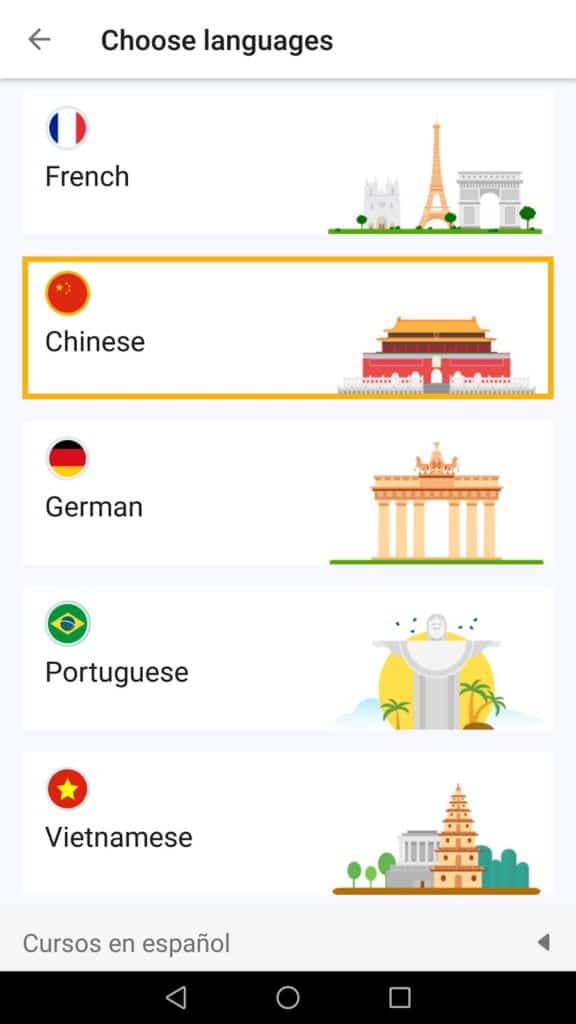
But even for languages like German, French, or Portuguese, I’d still recommend Lingodeer over Duolingo.
This isn’t to say that Lingodeer is perfect or that it should be the only resource you use to study. There are still quite a few things that could be improved. I’ll get into those a bit later though.
Currently, Lingodeer offers 12 courses, plus a beta version of Arabic. The courses include English, Japanese, Korean, Spanish, French, Chinese, German, Portuguese, Thai, Russian, Italian, and Vietnamese.
You can take courses in other languages besides English. For example, you could take an English course taught in Korean or a Japanese course taught in German.
For this review, I decided to try out the German, Chinese, and Spanish courses. I’m fairly advanced in both Spanish and Chinese but am brand new to German.
Course Structure
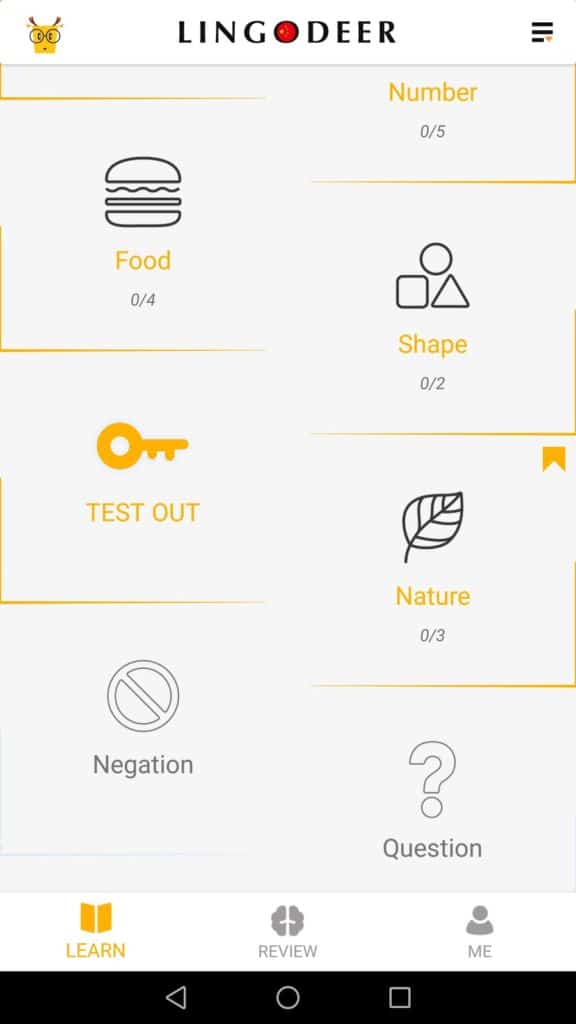
Lingodeer divides their lessons into different topics such as family, numbers, food, or health.
Before that though, each language starts out by teaching the alphabet. While it sounds obvious that this is where you should start, it’s not always the case with other resources.
For each language, I found the alphabet section to be quite comprehensive, perhaps overly so even. It goes beyond just the alphabet and looks fairly in-depth at the pronunciation, including things like word stress, exceptions, explanations, and how to make the sound, and there are lots of words you can click on to hear the pronunciation.
This section is a bit heavy but I’ve always felt like it’s worth spending a lot of time early on to master pronunciation. By itself, it may not be enough, but Lingodeer does go much further with teaching pronunciation here than you’ll see among other apps.
It may be smart to also use other resources like Speechling or italki to help you with your pronunciation.
After (or before if you’d prefer) completing the alphabet unit, you’ll move on to the topic-based units.
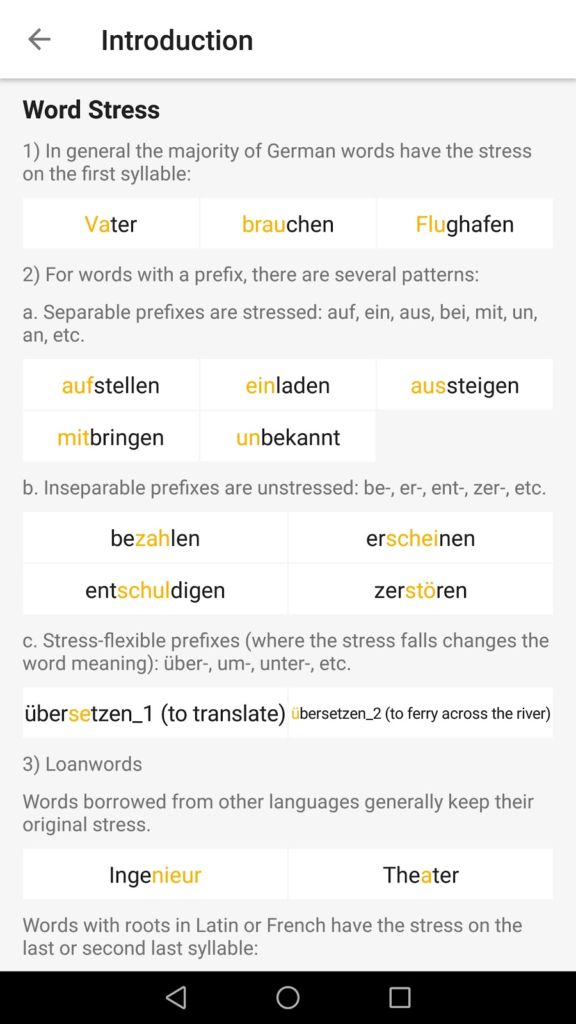
This works pretty well, but like most courses that split up their content this way, occasionally you’ll learn some less important content before learning more important words.
In the Chinese course, for example, you’ll learn the words for peach and pear before learning how to ask a question. Not a big deal.
Taking this a bit further though, somehow the words for lawyer and robot showed up in the first unit labeled Basics of the Spanish course. Obviously, these words are far from essential for absolute beginners. It’d be better if they had more appropriate vocabulary early on.
The German course did seem much more reasonable with what they taught in the beginning.
The order of the units and content of the lessons does seem to vary depending on the language you’re learning.
This is a good sign to me that they don’t simply replicate the content for each language like you may find with other resources. After trying Rosetta Stone, I got the impression that that’s what they were doing.
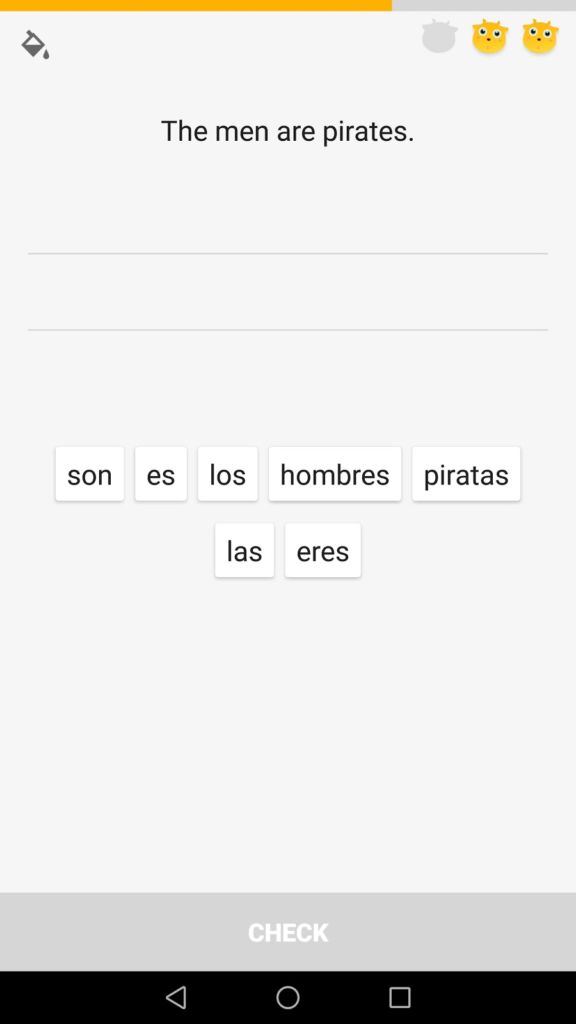
In fact, Lingodeer does seem to differentiate the content a bit according to the language they’re teaching. For example, the Spanish and Chinese courses taught different foods that would be more suitable for each language. So, it seems like there’s at least some attempt (perhaps minor) to make the lessons culturally relevant.
The programs include 200+ lessons. Each unit contains between 2-5 lessons as well as some grammar lessons which are called Learning Tips. Additionally, some languages include a story at the end of the unit.
If you’re not a complete beginner, you can jump ahead in the course by testing out of previous content. This is essentially just a test of the material covered where you’ll complete a bunch of exercises to prove that you know the content. You’re limited to three mistakes, if you make more than that then you’ll have to start over or complete the preceding lessons.
There were a couple of minor annoyances I found with testing out.
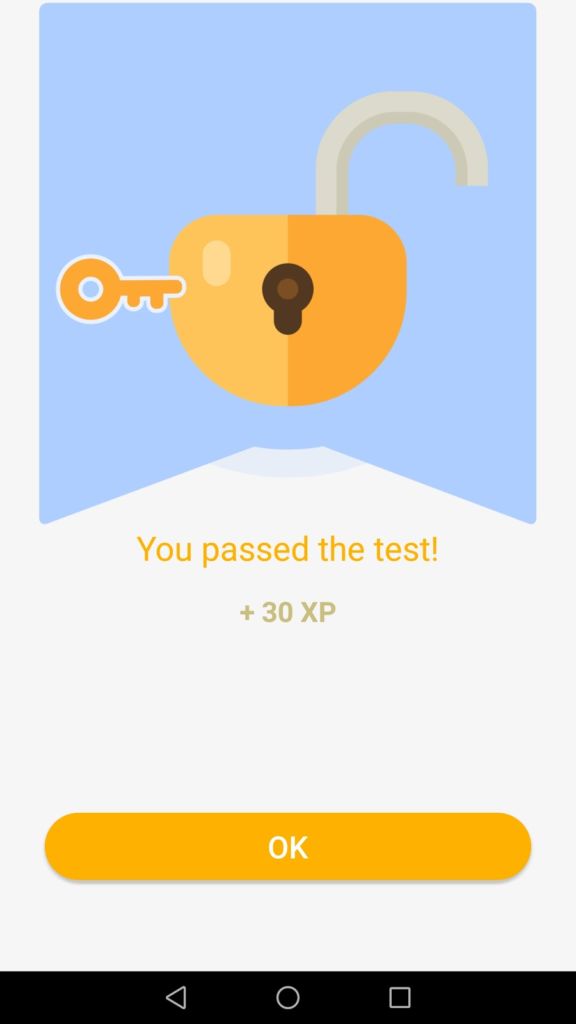
First, you have to test out of the units in order. So, if you’re more advanced, you may have to complete three or four of these tests to jump ahead to where you’d like to be. In reality, it’s not a huge deal. They’re fairly quick and if nothing else will be some review for you.
Another tiny annoyance I had is that after testing out of a section, you still won’t be able to look at all of the lessons in that unit. Each of the mini-units will be unlocked, but only the first lesson of each unit will be accessible.
So, despite testing out of the section, you still would need to complete the first lesson in a unit before trying the second lesson. It’d make more sense for all of the lessons to be unlocked once you test out of a section.
For nearly everyone though, this isn’t likely to be a real issue. Chances are if you test out of a section, you won’t try going back to complete the lessons. You’ll likely just continue on with the course.
Let’s now take a closer look at what’s included in each mini-unit.
A Typical Unit on Lingodeer
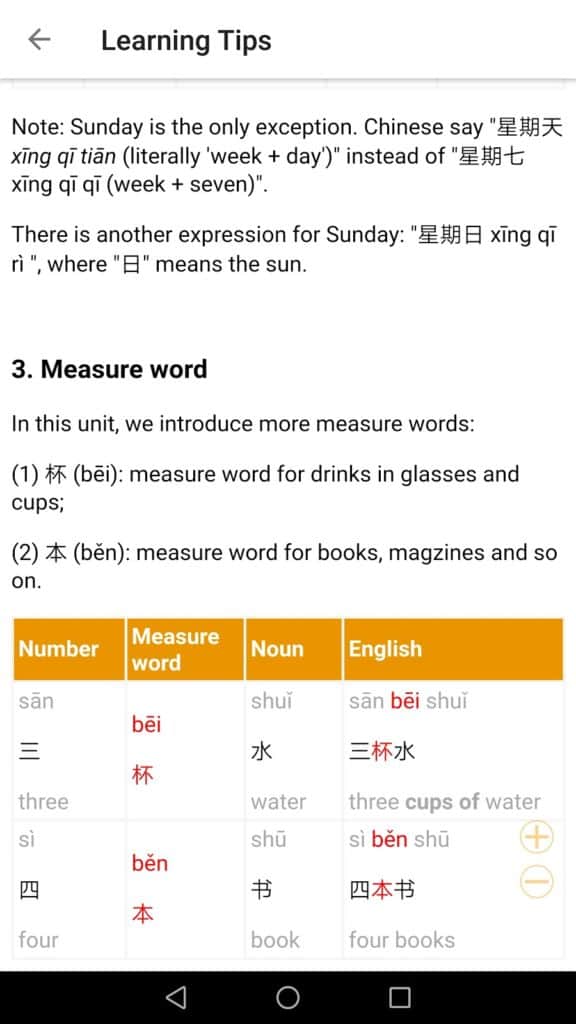
When you first open a unit on Lingodeer, you’ll see the first lesson. But, if you swipe left, you’ll find an incredibly useful section called Learning Tips.
Learning Tips
This section really is great.
A lot of language learning resources basically ignore grammar. The justification is often that children don’t learn grammar when they first start. However, you’re an adult, and learning grammar is probably going to make your life much easier.
The tips include lots of explanations and examples to help make things as clear as possible.
Lingodeer has also clearly put quite a bit of thought and time into this. Each language requires different explanations here and it’s not something that can quickly be copied from one language to another, because sentence structure varies so greatly between languages.
Lessons
Similar to Duolingo, the lessons are taught by completing lots of exercises. There does seem to be a bit more variety here though. The questions start out very simple before becoming more challenging.
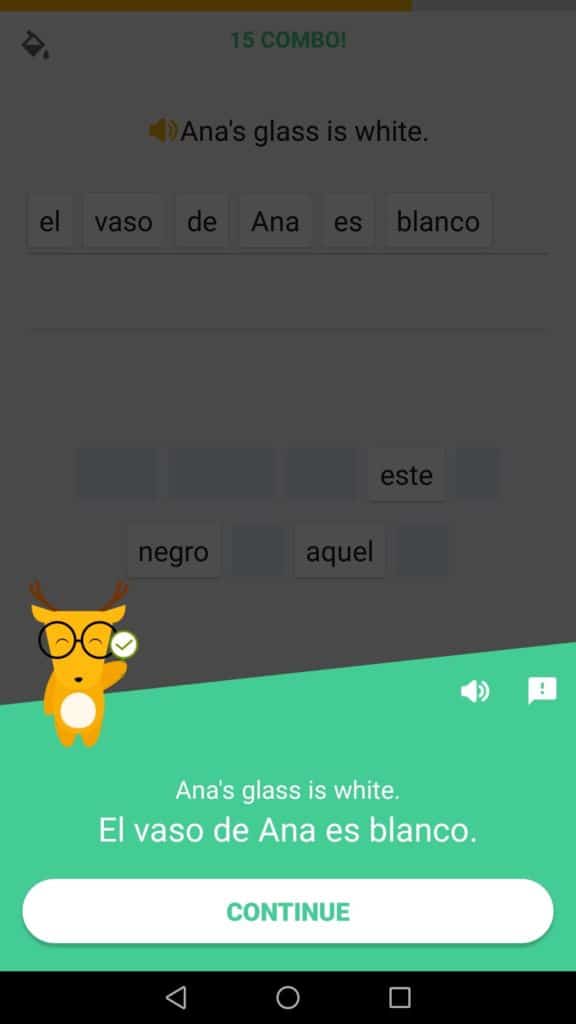
Question types include:
- Matching pictures to words
- Listening
- Speaking
- Multiple choice
- Removing words that don’t belong
- Adding words to the correct place
- Fill in the blank
- Matching
- Spelling
- Ordering sentences
- Writing sentences
The large variety of question types helps in two ways. First, it makes things more interesting so that you’re less likely to get bored and quit using Lingodeer. Second, it tests you on multiple skills, helping you to be more well rounded in the language you’re learning.
The questions work well together. Without a doubt, you’ll learn a lot by completing these lessons.
Review
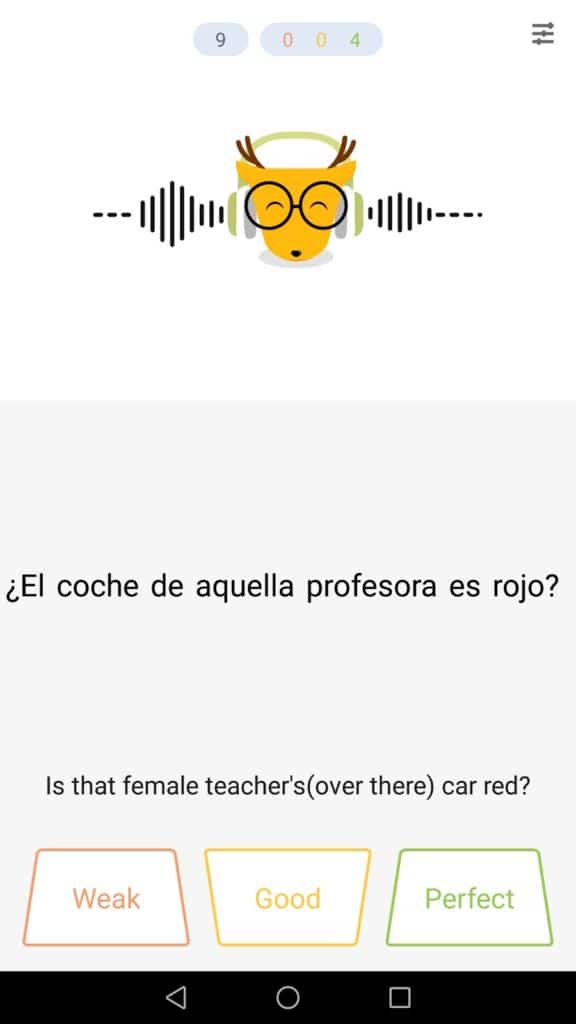
Obviously, if you’re studying a language, you’re going to want to occasionally go back and review what you’ve learned before. Lingodeer does a good job here as well.
There are a few different ways to review.
The first way looks similar to flashcards. First, you’ll hear a sentence. Then, you can show the answer which includes both languages. Depending on how well you remember the material, you’ll mark it as either weak, good, or perfect.
Another type of review exercise is called the 5-Min Quiz. The exercises are all very similar to the ones you’ve previously completed. It works well as a nice refresher.
You can also choose to review either vocabulary or grammar. While the vocabulary ones are pretty strictly vocabulary, the grammar will also include vocabulary. After all, it’s hard to practice vocabulary without also using some vocabulary.
A nice option is that you can select the lesson you want to review. So, if some are easy for you, you don’t need to review those unless you’d like to.
Stories
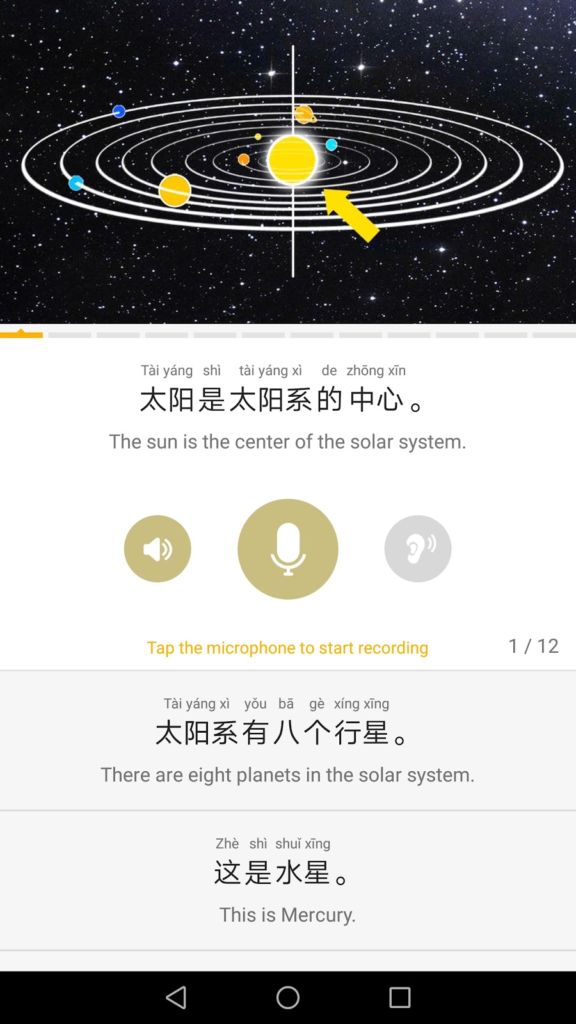
This section is quite a bit different than the rest of Lingodeer. First, you should note that while all the languages feature stories, certain Asian languages have more elaborate video stories. Over time Lingodeer will likely develop more complex stories for all the other languages as well.
The story section at the end of a lesson consists of a short video with captions. It’s somewhat related to the individual units.
In some of the languages, you will notice that the story takes things much further than the lesson content. For example, in the Nature unit of the Chinese course, the story includes the names of all of the planets.
There are comprehension questions that go with the story, and a speaking exercise in which you’ll record yourself telling the story. In the end, you can listen to yourself telling the whole story.
It’s pretty cool and a fun way to expand upon what you’ve learned in the lessons.
Achievement Challenges
Along with updating its interface to an intuitive, user-friendly experience Lingodeer also recently added a new element called achievement challenges. This is basically a way to get extra little serotonin boosts as you study, much like gamified elements in Duolingo.
Achievement challenges can appear in several different ways including a challenge to earn stars through studying every day to complete a “streak” or reaching a word or sentence mastery goal in your target language. You can see all your achievements from a new and improved statistics feature to help track your progress.
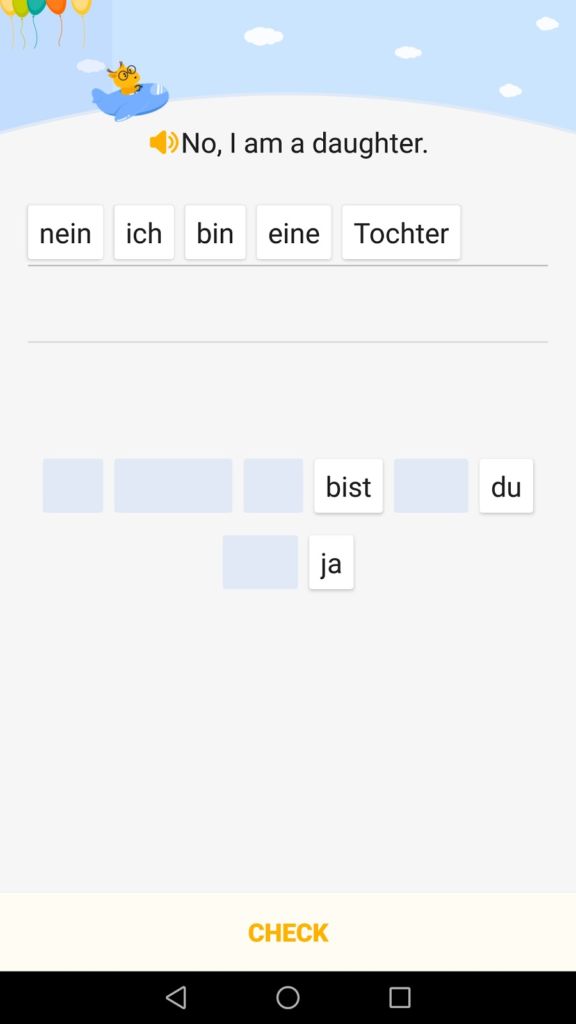
Clear audio. The sentences are recorded clearly by native speakers. This may sound like a small thing but it’s not. One of my biggest issues with Duolingo is that the audio wasn’t recorded for full sentences. This makes it really choppy and unnatural sounding. It’s a small thing but hugely important and Lingodeer has done a great job.
Good looking app. Although there are a few small issues with the app, for the most part, everything works well. The app has a sleek design that is intuitive to use.
In fact, LingoDeer recently updated its interface to offer new options like color coding and a circle tool so you can constantly track your progress, as well as new statistics options that let you see the words you have learned along the way.
Variety of exercise types. An issue with a lot of language learning apps is that they use only a few different types of exercises. This can quickly become tiresome when you use it over long periods of time, which may lead to boredom and loss of motivation. Lingodeer challenges you in lots of different ways throughout the lessons.
Clearly explained grammar. Lingodeer does not skip over the grammar part like some other language programs. They explain important grammar points much better than most competitors.
Review opportunities. Lingodeer makes it easy to review everything you’ve learned or just parts of certain lessons that you may have struggled with. This is great for making sure you’re not forgetting what you’ve already learned.
Some Room for Improvement
Sometimes the order things are taught doesn’t make sense. For the most part, Lingodeer does a good job of teaching useful language and structuring lessons that build upon each other well. But sometimes, the lessons include language that’s not useful for the level they’re at. The obvious example is the words robot and lawyer being taught in a basic Spanish lesson.
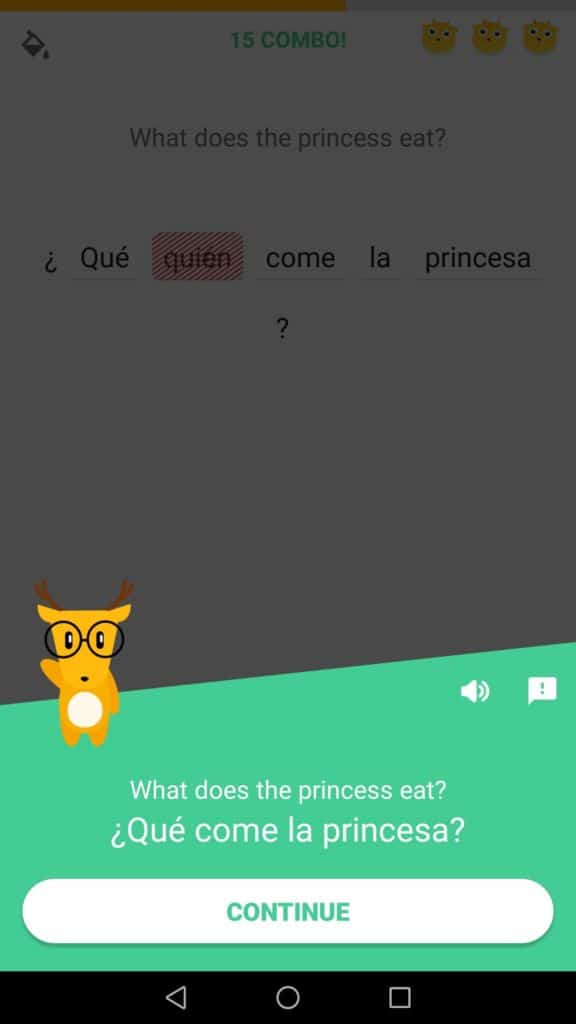
There are a few small kinks in the app. While the app works well and looks great, there are still a few weird things that it does, such as, lessons loading slowly and not letting you take lessons you’ve already tested out of.
Not sufficient for improving speaking skills. There are some speaking exercises on Lingodeer, but those won’t be enough to really develop your oral skills. A course like Pimsleur is much more focused on improving speaking ability.
That said, even in pricey language-learning programs that offer direct speaking software so you can use the microphone on your phone, you will notice some bugs and doubt its quality. For the best speaking practice, you really need in-person feedback.
You can get this by, finding a tutor on italki or using Speechling to get feedback on your pronunciation
Will only get you so far. Lingodeer is an awesome way to get introduced and started learning a language but it won’t take you all the way to fluency. At some point, you’ll need to move on to other resources.
Alternatives to Lingodeer
Pimsleur

Pimsleur is one of the most popular and longest-standing resources out there for learning a foreign language. Its courses place a strong emphasis on aural and verbal communication skills, paying less attention to grammar explanations and reading or writing skills.
There are over 50 language courses available with Pimsleur, and the bulk of the material is taught with audio lessons. Check out our full review here!
FLUENTU

FluentU is a language-learning platform that uses real-world videos and interactive subtitles to create an immersive learning experience. The videos take on a variety of forms, including commercials, music videos, interviews, and more. Accompanying quizzes give users the chance to practice the language used in videos.
FluentU offers videos in ten different languages and is available for iOS, Android, and on the web. Most of its content is beyond the beginner level, but it has videos for learners at all levels. Check out our full review here!
olly (I will teach you a language)

Do you struggle with the repetition and boring lessons offered in many language courses? If so, you may want to check out Olly Riachard’s online Storylearning courses currently offered in eleven languages, this program uses an ongoing narrative to keep you interested and help you learn a language through storytelling.
Storylearning does a good job of focusing on many elements of each language including grammar, culture, and listening comprehension. The only downside is that it remains a basic online course and is not available as an app. Plus, it does not use direct speech software to help you practice your pronunciation.
How to Use Lingodeer to Learn a Language
If you like the idea of Lingodeer’s fairly comprehensive beginner course check out some tips to see how to make the msot of your study time.
Be consistent
If you have ever studied any language using any tools before now, you know that consistency is key. No matter how good Lingdeer’s lessons are, they will not do you much good unless you consistently sign in to the app and work through both new lessons and review sections.
Lingodeer does a good job rewarding your consistency, by giving you achievement awards when you succeed in studying for several days in a row. But honestly, this is on you–you will head toward fluency so much faster if you can set aside a daily study time even just for 30 minutes!
If this seems impossible at first glance, try tracking your daily activities for a week. To do this, use an online calendar or a printed weekly planner and note how you spend your time all day in half-hour increments.
At the end of the week, look to see if you have any regular chunks of time where you could swap out a non-essential activity (like scrolling TikTok) for a brief lesson on Lingodeer.
Use all the available features
Another way to make the most of Lingodeer is to make sure you use all its available features. For example, use the flashcards that come with your lessons as a handy review mechanism.
If you find yourself struggling with listening comprehension in the audio components, use the option to slow down the audio so you can hear each syllable in a word or phrase.
When the lesson prompts you to say something, make sure you actually repeat the word out loud! You may feel a little silly, but this speaking activity is training your mouth to pronounce new sounds, and helping you permanently remember the new words as well.
Repetition is important
Speaking of repetition, some Lingodeer users find it helpful to circle back to past lessons regularly as a way of keeping the material fresh and truly mastering it. Depending on how much time you have available you may want to work this repetition into your study time as well as advance into new lessons.
Even if you don’t take this more circular approach, make sure you don’t move on from a lesson until you feel like you have learned the material. It can seem tempting to keep moving fast unlocking new achievements and earning more points as you go. But remember, the true reward is taking the next step fluency in your target language!
Additional learning tools
Lingodeer offers a much more comprehensive approach to a language than other language-learning apps like Duolingo. That said, it will still work best when paired with additional learning tools.
For example, one of the most important things you need to develop fluency in a language is a chance to practice real-life conversation. It’s hard to get this within most online or app-based courses, so unless you can afford to pay a tutor or take an in-person class, your best bet is to seek out conversation partner apps like HelloTalk.
This free resource helps connect you with fellow language learners who speak your target language. This way you can try out your new vocabulary and pronunciation in a safe space.
Additional activities
Finally, you should also look for activities you can build into your daily routine to constantly build your language skills.
Try sticking post-it notes with the appropriate word in your new language on all the items in your house, like chairs, TVs, and food items. Read newspaper headlines from a paper that comes from a country speaking your target language each morning before you check your local news.
This immersion approach can mean swapping out your regular Netflix shows for shows or movies in your target language. Use subtitles so you can enjoy the story, but try pausing once and a while to repeat a word or phrase you recognize.
If you have a long commute to work, try listening to music or podcasts in your new language. The more you hear the sounds of the language the more quickly you will develop strong listening comprehension skills!
Final Thoughts
I’m a big fan of Lingodeer. Although it’s not as well known as Memrise or Duolingo, it’s my favorite app that teaches languages through lots of exercises. Lingodeer does a great job of making it easy for anyone to start learning a language.
Lingodeer is an excellent resource, though it does work best when paired with other learning tools like a conversation partner app.
That doesn’t necessarily mean it’d be the best option for language learners or my first choice personally. The fact is that there are a lot of quality resources out there. The best option often depends on the language that you’re learning.

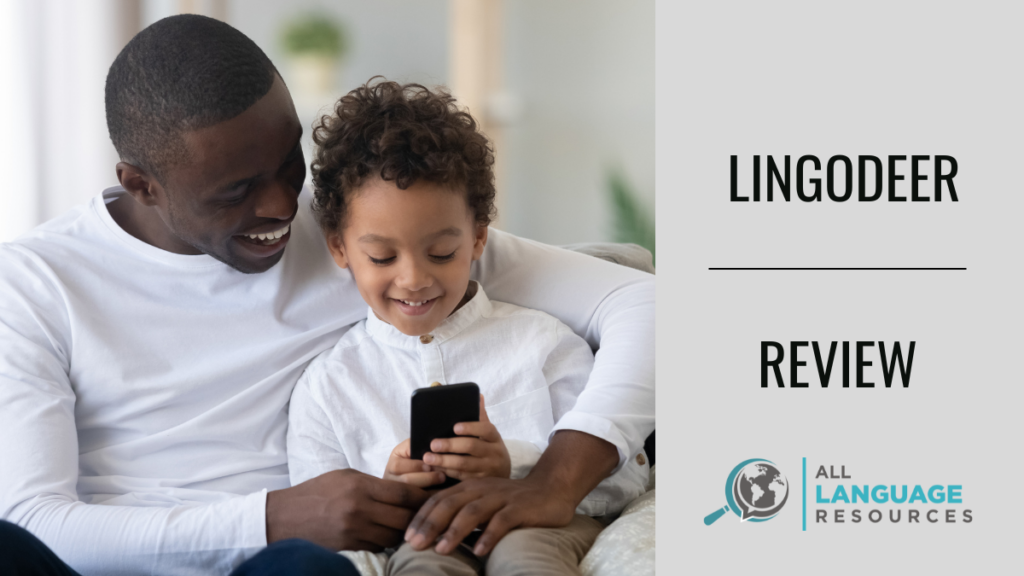
Hey, thanks for sharing the feedback. I completely agree that we should have the dates of the reviews posted on here. These apps really do change very quickly and we spend a ton of time updating reviews frequently, so not doing making it clear when the last update was is kind of doing us a disservice. That’s just an oversight on my part – I’m making a note of changing that now.
Hello there,
Thanks for these reviews, I really appreciate when people share their experiences and it’s more than just “Bad app” on the app store.
Duolingo has really made me angry with many bad changes which in my opinion lowered the educational value and instead just raised their income. Also the bugs that just caused me to see more ads, which I suspect were put in the app on purpuse (just a suspicion, no proof there, but it had happened almost every day for several months).
Finally, I got tired of Duolingo and tried Lingodeer. The price is so much lower (got half off for a year)… I love Lingodeer so far. I’m learning Japanese and Vietnamese and both courses seem great. Stories are the only thing I have a problem with. They often have words that I just don’t know in them and I can’t answer the questions in the stories, because I just don’t understand the new words and even the questions are asked in a way that hasn’t been taught at all, so I hope they do something about it. Right now, the stories are just unusable for me. That’s only in Japanese for me though. The Vietnamese course seems amazing so far and my Vietnamese girlfriend approves too. I highly recommend Lingodeer. There’s a few bugs too, it’s not perfect, but when it comes to Duolingo vs Lingodeer, Lingodeer wins by a long shot. Vocabulary, grammar, slow nice progress through topics, price. All of these seem way better to me in Lingodeer.
Just a little side note. I feel like it would be much better if you posted the dates of reviews. Honestly these apps are often changing on monthly basis and it doesn’t really make any sense to not post what month and year is the review from, at least for an honest website, which I think this website is. Now I don’t know when this review was made and how different the app can be now. It can be a little misleading this way e.g. when there’s a big update like Duolingo change to the crown system, which change the whole app.
That’s strange. I just uninstalled the app, reinstalled it, and tried using it without signing in. I’m still seeing courses for Japanese, Korean, Spanish, Chinese, German, Vietnamese and Russian. It seems like a lot of the lessons are still free for me too. I was able to test out of some levels of the Spanish course and keep studying. Most of the prices I’m seeing are actually cheaper than they were before – $4.99/mo, $9.99 for 3 months, $14.99 for a year. The only one that looks more expensive is the lifetime option costing $59.99. They also seem to have a new DeerPlus app but I haven’t tried that.
I really appreciate your website and your detailed, unbiased reviews. That said, I’m not sure when this review was written, but as of May 2019, it seems to be obsolete. Lingodeer in the App store now only offers Korean, Japanese, and Chinese. Very little in the app is still free and the pricing structure is about double what you mentioned, with no lifetime option offered. I am disappointed because your review made it sound like exactly what I wanted for learning Spanish. Thanks, anyway.
Thanks a lot for taking the time to leave a comment. I’m sure you’ll find your Spanish improving quickly with Baselang!
Dear Nick,
Thank you , Gracias, Dank jij wel x100 for your review of these Spanish learning tools. It is so confusing and overwhelming to find a good program. I was so happy to read your honest reviews of the various programs I WAS interested in. I was going to go with SpanishPod 101, but found they had too many scattered pieces of matierial all over the place. I did like their podcast and listening comprehensive exercises.
So after reading you reviews, it looks like I will go with Baselang, as I have the extra time to take plenty classes to benefit from it’s “unlimited” offerings. Also I insist on a strong curriculm because I have always been a “class room” learner and believe in learning Spanish basics and not just “phases.” I will be sharing this site with others…My sincerest thanks!